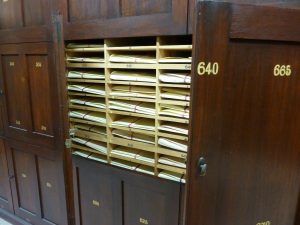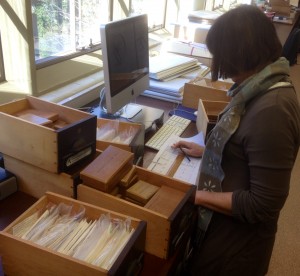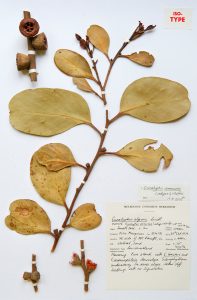This week, Australia’s Virtual Herbarium (AVH) welcomed a new data provider: the University of Melbourne Herbarium (MELU). Home to approximately 100,000 specimens, MELU is the largest university herbarium in Australia. About 10 per cent of the collection has been databased to date, adding over 9,000 records to AVH.
The MELU herbarium was established in the School of Botany in 1926 with a donation of plant specimens from the Rev. Herman Montague Rucker Rupp, a former student of Trinity College at the University. The collection grew throughout the 20th century thanks to donations from state and private herbaria, and through the efforts of staff and students in the School of Botany.

Although small in size compared to the state and territory herbaria, it is the largest and most botanically diverse university herbarium, and makes a valuable contribution to our combined knowledge of the Australian flora. All major botanical groups are housed in the collection, but it is particularly rich in algae and non-vascular plants. Significant collections include:
-
An algae collection of approximately 30,000 specimens, which was established by the renowned phycologist, Dr Sophie Ducker. MELU volunteers have recently databased some of Ducker’s collections from Madagascar and the Mascarene Islands.
-
4,500 mosses and liverworts collected by George Scott, the foremost authority on temperate mosses and liverworts. Scott is credited with rekindling interest in the study of bryophytes in southern Australia and was the teacher of at least three of today’s leading Australian bryologists. MELU have recently begun databasing the Scott collection, which is available in AVH alongside records of Scott specimens held in other herbaria.
-
A collection of leaf-inhabiting microfungi specimens, slides and illustrations from Dr Harry Swart, a mycologist, plant pathologist, and artist of architectural and humorous drawings. Swart joined the School of Botany in 1966 as a Senior Lecturer. Leaf-inhabiting fungi are a highly diverse but relatively unexplored group of fungi that are prevalent on many of the iconic Australian plant genera such as Eucalyptus and Banksia.
More MELU specimen records will be added to AVH as the collection continues to be databased by a team of volunteers – who are mostly undergraduate students – and herbarium staff. Volunteering at the herbarium gives students great insights into botanical diversity as well as an understanding of how natural history collections are managed.
“Students get to see a range of different plants, which gives them a good idea of morphological variation and spotting characteristics, while helping us curate the collection”, says Herbarium Curator, Dr Gillian Brown.
Although all herbaria are important research collections, university herbaria, in particular, have an important role in teaching the next generation of botanists. The herbarium is a valuable teaching resource, explains Brown.
“Specimens are used in practical classes to demonstrate the diagnostic features of different plant groups and some subjects require students to prepare their own specimens, which in turn are incorporated into the collection.”
One of the most important teaching and research collections is a collection of approximately 7,000 Eucalyptus specimens collected by staff (including Professors David Ashton and Pauline Ladiges) and students over the years. The most significant of these is the monocalypt collection – Eucalyptus subgenus Eucalyptus – which comprises about 2,600 specimens from western and eastern Australia. This collection encompasses all species of the subgenus and includes voucher specimens sampled for DNA sequencing, seedlings cultivated from the specimens (which display characters useful for identification) and collections preserved in alcohol for microscopy. Multiple samples from different populations exist for many species, illustrating their geographic and morphological variation.
There are 16 herbaria in Australian universities, which together house over 420,000 specimens. MELU is only the second university herbarium to join AVH. The N.C.W. Beadle Herbarium (NE) at the University of New England joined AVH in 2013, and has over 80,000 records in AVH. Several other university herbaria are working towards delivering data to AVH, and we hope to have the La Trobe University Herbarium (LTB) and James Cook University Herbarium (JCT) on board in the coming months.





